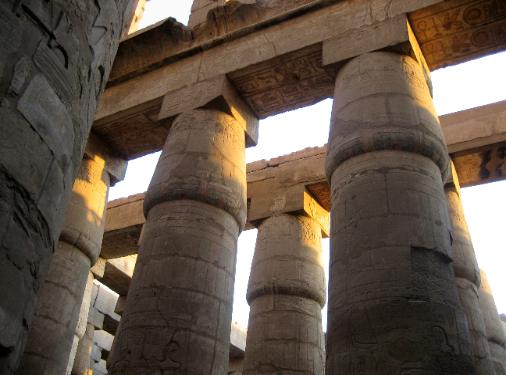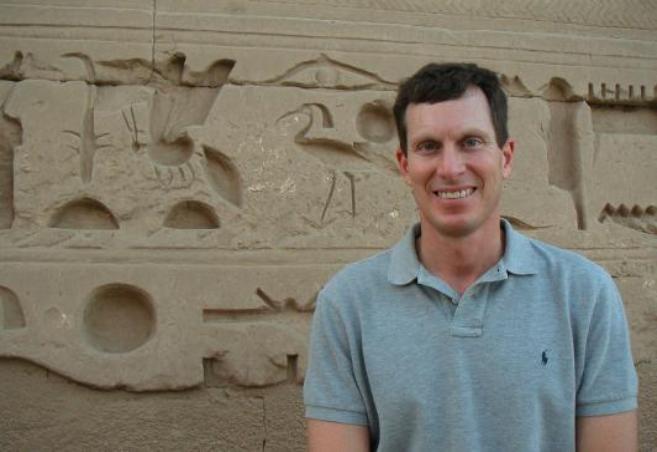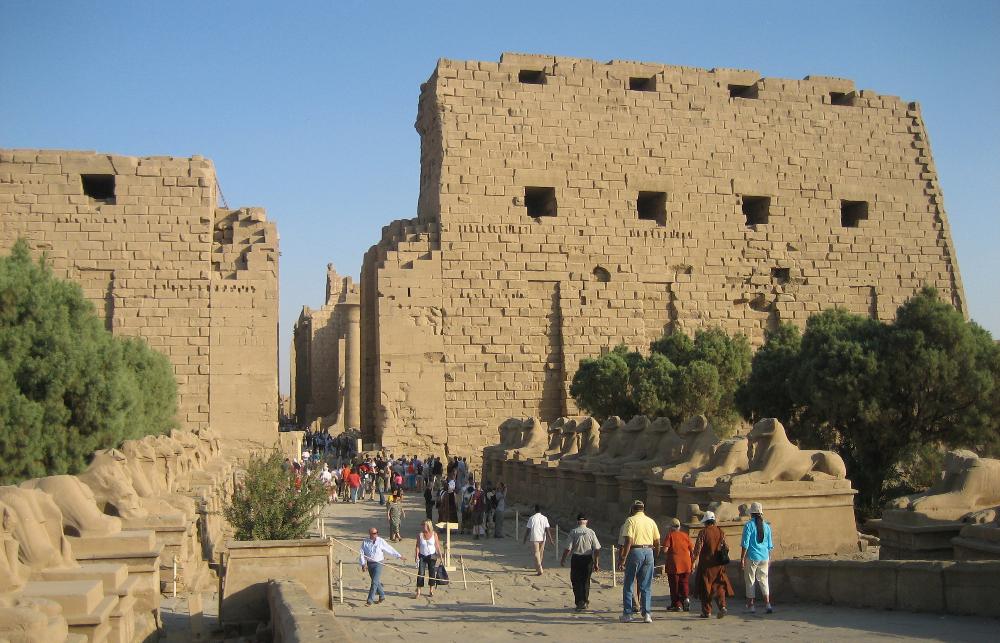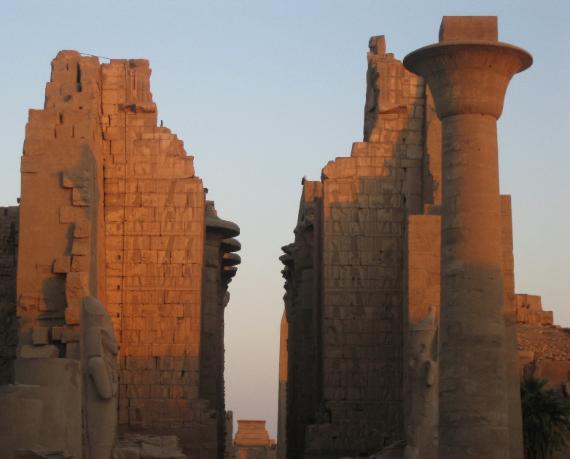
Where We Be


| When you first arrive at Karnak Temple, you enter through the majestic West Gate |
| Karnak Temple -- Luxor, Egypt |
| The Avenue of Rams at the West Gate is a famous landmark |
| Late afternoon sunlight glows on ancient shaped stones |


| Queen Hatshepsut's obelisk is the tallest in Egypt. Carved from a single piece of stone, it took seven months of labor just to cut the monolith out of the quarry. |
| The original paint colors are still quite evident on the underside of this stone |
| Pharaoh's wife stands on the feet of her husband. She is depicted as being much smaller than pharaoh himself |
| Happily trying to decode the hieroglyphics deeply etched into the walls and pillars |
| It takes ten of us to get our arms around just one of these pillars! |
| The pillars are thicker and heavier and placed much more closely together than the slender columns in a Greek temple, but that’s exactly what lends them so much weight and solemnity |
| This "temporary" mud-brick ramp is still in place today, located at the one unfinished pylon (or gate) |
| Serene pharaoh, supremely confident, forever young. Pharaohs are nearly always depicted as young and perfect. |
| Amazingly well preserved art |
| Karnak Temple is actually a complex of temples. In fact it is the largest ancient religious site in the world, the combined achievement of generations of builders and pharaohs. |
| Modern Egyptians wear a mix of clothing styles, apparently based on individual preferences |
We fly from Cairo to Luxor, a one-hour flight,
and are taken to the Presidential Nile Odyssey
ship, our home for the next six days during our
Nile River cruise. We meet our tour guide,
Michael, who has a wonderfully dry sense of
humor and speaks in clear British English. He
tells us in his deep authoritative voice, “The
trip to Karnak Temple will be THE highlight of
your trip to Egypt," but he says the same about
our visit to Luxor Museum, the West Bank, Abu
Simbel, and every other important sight we see.
Certainly the Great Hypostyle Hall in Karnak
Temple is beyond stunning. The sun slants in
on a forest of thick pillars, casting a soft glow
on the enormous stone columns. We stretch
out our arms with other members of our group
and it takes ten of us to reach around just one
pillar. Michael has us close our eyes and
imagine this place as it would have been at the
height of Egyptian power. As he softly intones
names of ancient pharaohs and priests, their
deeds and misdeeds, their daily practices, their
dreams, he conjures up their presence in this,
their holiest of temples. The sun sets, the
stones glow reddish gold, and we wander on
our own through this magical place. Without a
doubt, this really is a highlight of our trip.
and are taken to the Presidential Nile Odyssey
ship, our home for the next six days during our
Nile River cruise. We meet our tour guide,
Michael, who has a wonderfully dry sense of
humor and speaks in clear British English. He
tells us in his deep authoritative voice, “The
trip to Karnak Temple will be THE highlight of
your trip to Egypt," but he says the same about
our visit to Luxor Museum, the West Bank, Abu
Simbel, and every other important sight we see.
Certainly the Great Hypostyle Hall in Karnak
Temple is beyond stunning. The sun slants in
on a forest of thick pillars, casting a soft glow
on the enormous stone columns. We stretch
out our arms with other members of our group
and it takes ten of us to reach around just one
pillar. Michael has us close our eyes and
imagine this place as it would have been at the
height of Egyptian power. As he softly intones
names of ancient pharaohs and priests, their
deeds and misdeeds, their daily practices, their
dreams, he conjures up their presence in this,
their holiest of temples. The sun sets, the
stones glow reddish gold, and we wander on
our own through this magical place. Without a
doubt, this really is a highlight of our trip.
| Wandering through the Great Hypostyle Hall of Karnak Temple near sunset has got to be one of the most magical things we've ever experienced |

| How did the Egyptians build this immense place with no modern machinery? |








| Hieroglyphics are so tantalizingly mysterious |





| Luxor Museum |
| At the entry to Luxor Museum, arguably the best museum in Egypt |
Luxor Museum is arguably the best museum in
Egypt, and that's saying a lot given that it has
the blockbuster Egyptian Museum in Cairo as
competition. The layout and lighting at Luxor
Museum are lovely, and it’s a pleasure to walk
through the exhibits. Perhaps the highlight is a
statue of the great warrior-pharaoh, Thutmose
III. Many believe it is one of the best statues
ever carved in Egyptian times. The elongated
and truly alien-looking head of the pharaoh
Akhenaten is also something to behold. You
can always tell when a statue or piece of art
comes from his reign because it looks radically
different from every other period in Egyptian
history. This heretical pharaoh repudiated all
the old gods of Egypt and said there was only
one god, Aten, the sun god, thus invoking the
wrath of nearly every priest in ancient Egypt.
After his death, his name -- and the name of his
son King Tutankhamun -- was chiseled out of
virtually every monument and record, to the
point that they nearly disappeared from history.
Egypt, and that's saying a lot given that it has
the blockbuster Egyptian Museum in Cairo as
competition. The layout and lighting at Luxor
Museum are lovely, and it’s a pleasure to walk
through the exhibits. Perhaps the highlight is a
statue of the great warrior-pharaoh, Thutmose
III. Many believe it is one of the best statues
ever carved in Egyptian times. The elongated
and truly alien-looking head of the pharaoh
Akhenaten is also something to behold. You
can always tell when a statue or piece of art
comes from his reign because it looks radically
different from every other period in Egyptian
history. This heretical pharaoh repudiated all
the old gods of Egypt and said there was only
one god, Aten, the sun god, thus invoking the
wrath of nearly every priest in ancient Egypt.
After his death, his name -- and the name of his
son King Tutankhamun -- was chiseled out of
virtually every monument and record, to the
point that they nearly disappeared from history.